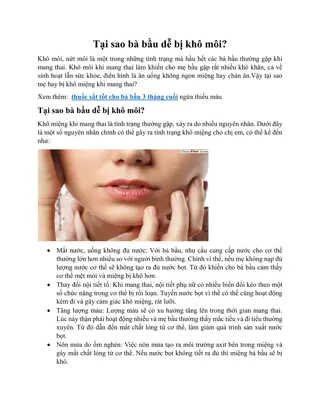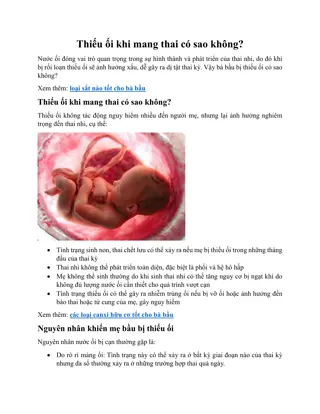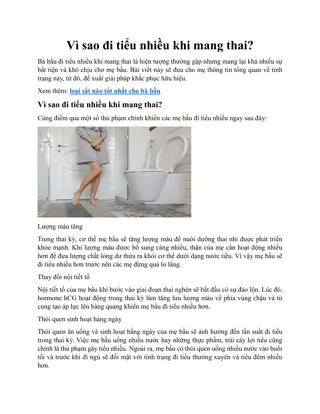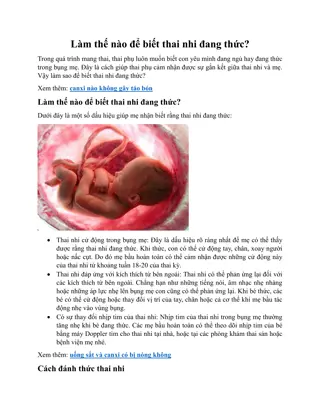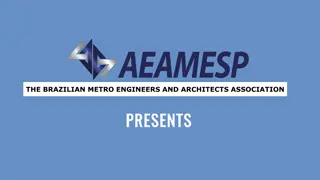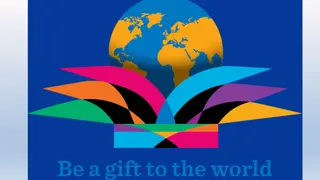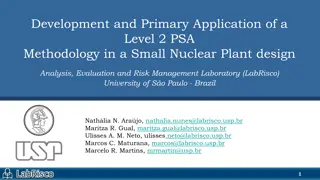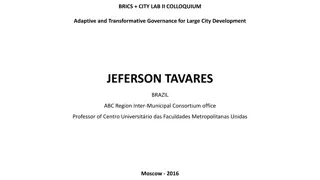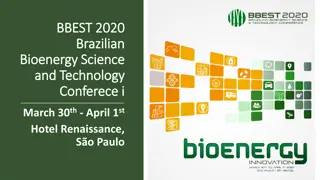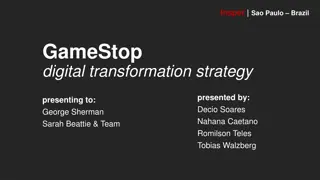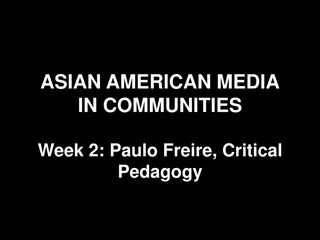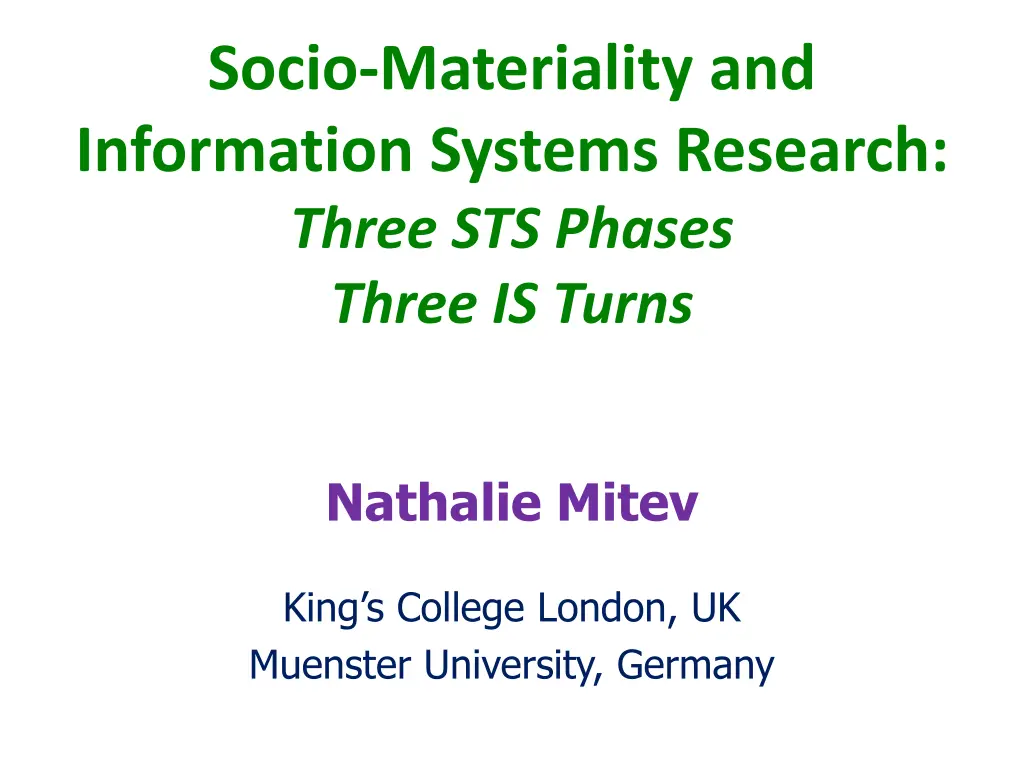
Sociomateriality and Information Systems Research Phases
Explore the evolution of Information Systems research through Socio-Materiality concepts and Science & Technology Studies, covering phases from Social Shaping of Technology to Actor-Network Theory, emphasizing the interplay of social and material elements in technology studies.
Download Presentation

Please find below an Image/Link to download the presentation.
The content on the website is provided AS IS for your information and personal use only. It may not be sold, licensed, or shared on other websites without obtaining consent from the author. If you encounter any issues during the download, it is possible that the publisher has removed the file from their server.
You are allowed to download the files provided on this website for personal or commercial use, subject to the condition that they are used lawfully. All files are the property of their respective owners.
The content on the website is provided AS IS for your information and personal use only. It may not be sold, licensed, or shared on other websites without obtaining consent from the author.
E N D
Presentation Transcript
Socio-Materiality and Information Systems Research: Three STS Phases Three IS Turns Nathalie Mitev King s College London, UK Muenster University, Germany
The bigger picture Organisation Theory Post-marxist/structuralist social theories: Structuration theory (Giddens), habitus (Bourdieu), governmentality (Foucault), constructionism (Berger & Luckman), constructivism IS Research Socio-technical approaches (1970s-80s) Systems development, socio-technical design, ethics, action research Interpretivism (1990s-2000s) Qualitative research, structuration theory (Walsham), contextualist and institutional approaches, agency, emergence, practice (Orlikowski) Sociomateriality (2000s-10s) Non-dualism, actor network theory, symmetry, entanglement The return of the material
Tools and Turns in Studying Technology atWork (Orlikowski, 2015) First turn: significance of the social Second turn: primacy of practice Third turn: materiality matters
Science & Technology Studies Three phases: Social Shaping of Technology (SST) Social Construction of Technology (SCOT) Actor-Network Theory (ANT) Sociomateriality
SST, SCOT and ANT Away from technological determinism and towards understanding socialprocesses - social shaping - social construction - structuration - Open black box of technology to sociological analysis to examine process and content of technology, attending to actions, meanings, norms,contexts - interpretations - interactions - emergence
Phase 1 Social Shaping of Technology MacKenzie & Wajcman (1985, 1999) A radical reaction to technological determinism Technology shaped by social interests Social relations built into technology during design Dominant groups: science and existing technology, economics, the state, gender, etc. Attention to macro political, economic, cultural interests and values Classic examples Gendered printing technology (Cockburn, 1985) Edison s design of a system shaped by economic forces (Hughes, 1985) Moses Bridge: artefacts have politics (Winner, 1986)
FIRST TURN: SIGNIFICANCE OF THE SOCIAL Orlikowski s Structurational Model of Technology (1992)
Phase 2 Social Construction of Technology (Pinch, Bijker, Collins 1980s-90s) Technological development non-linear, multi-dimensional, no one best way Interested in how the social is embedded in the technical through interpretive flexibility Stabilisation/closure of this flexibility Methodological symmetry: controversies give insights into closure processes (not hindsight) Connect closure with wider social structures Role of actors and institutions in settling controversies Technological content related to the social via meanings given and negotiated by actors (relevant social groups)
Orlikowski and Gash s Technological Frames (1994) - Lotus Notes Case Study - (Harnisch, Kaiser, & Buxmann, 2013)
Second Turn: Primacy of Practice Deepening the commitment to practice (Shatzki, 2002) Structures are enacted -not embedded or appropriated - technologies-in-practice Extending a practice lens to other domains - e.g., knowledge, coordination, network relations, strategy, consulting, autonomy
The Third Turn: Materiality Matters human & non-human actors treated equally
Phase 3 Actor Network Theory (Callon & Latour, 1980s-2000s) Away from macro-sociological analysis through detailed inquiry into local, contingent processes Ethnomethodology Scientific activities not just socially conditioned but constructed through micro- social phenomena Micro processes Pervasive social dimension
Actor-Network Actor-Network Construction of facts a collective process through network-forming Translation by fact-builders of interpretation of their interests and that of the people they enrol Obligatory passage point Stabilisation of alliances and social interests is result of controversy in the making leading to Irreversibility through consensus reaching Seamless web formation to be described (rather than explained) and enables to consider science, technology, economics, politics Heterogenous human and non-human entities (actants) make the network not to include intention but to reflect: - technology is not plastic and cannot be shaped infinitely by social forces - Symmetrically, technology is not driven solely by its own internal logic
Entanglement and Performativity Entanglement (Pickering, 2010) Not assume a priori discrete entities or given processes Posthumanist performativity (Barad, 2007) Explore how specific sociomaterial enactments reconfigure reality differently in practice through inclusions andexclusions
Practices are entangled Practices are performative The material and social are inseparable Practices make cuts (inclusions and exclusions) that make particular distinctions, boundaries, and properties of pheno- mena determinate-in- practice Primary unit is not independent objects with inherent boundaries and properties, but phenomena socio- materially enacted inpractice Specific socio- material enactments of phenomena perform reality in practice
PRACTICE THEORY+ ANT+PERFORMATIVITY SOCIOMATERIALITY (Orlikowski, 2007) Performative entanglement (intentions cannot be attributed to just humans, they are effects of constitutive assemblages) SOCIO-MATERIALITY (Leonardi, 2011) Material performativity, human agency (only humans have intentions)
Agential Realism (Orlikowski) Critical Realism (Leonardi) Ontology Fused sociomaterial People imbricate social and material agencies Epistemology Analysts make arbitrary distinctions about what is social and material (agential cuts) when looking at a unified whole ( socio- material ). Analysts make determinations about how and why the separate social and material become the socio-material and persist that way over time. Materiality There is no materiality. There is only sociomateriality. The arrangement of an artifact's physical and/or digital materials into particular forms that endure across differences in place and time. Social There is no social. There is only the sociomaterial. Abstract concepts such as norms, policies, communication patterns, etc. Sociomaterial The inherent inseparability between the material and the social. Enactment of a particular set of activities that meld materiality with institutions, norms, discourses, and all other phenomena we typically define as social. Practice A sociomaterial accomplishment. The space in which social and material agencies become constitutively entangled through the process of imbrication. (Leonardi, 2013)
Non-essentialist STS spectrum Weak Constructivism (Kling, 1992; McLoughlin & Harris, 1997) Strong Constructivism (Woolgar & Grint, 1997) Nature of technology has some bearing technology has an effect Critical dimension of social structures Middle position ? No distinction between the social and the technical Both locally constructed, emergent and contingent Technical capacities indeterminate and open to interpretive flexibility during design and use Accused of purism Difficult to use Criticised for being determinist
Implications for IS research? The sociomaterial turn has brought back the material in organisational research - Debates about the relationships between the social and the material. Does it matter? - Other STS concepts? controversy, inscription, translation, action at a distance, ir/reversibility - Methodological issues: network boundaries, spokes- persons (agential cuts), pervasiveness of the social - Missing? symbolic and discursive aspects of artefacts, power and politics, socio-historical and cultural contexts, collective/societal action, environmental and community dimensions, gender, race, emancipation (post-Marxian, post-colonial technoscience)
Anderson, W. (2002). Introduction: postcolonial technoscience, Social Studies of Science, 32(5-6), 643-658. de Vaujany, F.X. & N. Mitev, De la mat rialit en th orie des organisations: tour, retour, detour? In F.-X. de Vaujany, A. Hussenot, & J. F. Chanlat (Eds.), Th orie des organisations: les nouvelles tendances, Paris: conomica. Doolin, B., & Lowe, A. (2002). To reveal is to critique: Actor-network theory and critical information systems research, Journal of Information Technology, 17(2), 69-78. Gond, J. P., Cabantous, L., Harding, N., & Learmonth, M. (2016). What do we mean by performativity in organizational and management theory? The uses and abuses of performativity, International Journal of Management Reviews, 18(4), 440-463. Harnisch, S., Kaiser, J., & Buxmann, P. (2013). Technological frames of reference in software acquisition decisions: Results of a multiple case study, ICIS 2013. Introna, L. (2013) Performativity and the becoming of sociomaterial assemblages In Materiality and Space in Management and Organization Studies, edited by F-X de Vaujany and N. Mitev, Palgrave. Leonardi, P. M. (2013). Theoretical foundations for the study of sociomateriality, Information and Organization, 23(2), 59-76. Mitev, N. & D.A. Howcroft (2011) Post-structuralism, social shaping of technology and actor network theory: what can they bring to IS research? In Oxford Handbook on Management Information Systems, edited by W. Currie & R.G. Galliers, Oxford University Press, 292-322. Orlikowski, W.J. (1992). The duality of technology: Rethinking the concept of technology in organizations, Organization Science, 3(3), 398-427. Orlikowski, W. J., & Gash, D. C. (1994). Technological frames: making sense of information technology in organizations. ACM Transactions on Information Systems, 12(2), 174-207. Orlikowski, W.J. (2000). Using technology and constituting structures: A practice lens for studying technology in organizations, Organization Science, 11(4), 404-428. Orlikowski, W.J. (2015) Research on technology atwork: Exploringtoolsand makingturns, ICIS Doctoral Consortium, Fort Worth, Texas, 10 Dec 2015. Pozzebon, M., Diniz, E., Mitev, N. de Vaujany, F.-X., Leca, B. & Pina e Cunha, M. (2017). Joining the sociomaterial debate, RAE-Revista de Administra o de Empresas, Special Issue on Sociomateriality, 1-10. Willey, A. (2016). A world of materialisms: Postcolonial feminist science studies and the new natural, Science, Technology, & Human Values, 41(6), 991-1014.




